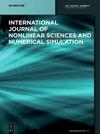变热物性运动边界问题的Legendre小波残差法
IF 1.5
4区 工程技术
Q2 ENGINEERING, MULTIDISCIPLINARY
International Journal of Nonlinear Sciences and Numerical Simulation
Pub Date : 2022-10-19
DOI:10.1515/ijnsns-2019-0076
引用次数: 9
摘要
摘要本文的主要目的是描述当导热系数和比热随温度和时间线性变化时,具有传导和对流效应的一维移动边界问题。由于热导率和比热的变化,数学模型具有非线性。引入了勒让德小波残差法,得到了高精度的解。将地表热流通量作为时间的指数函数,潜热作为位置的指数函数。当物性不变时,采用伽辽金法求解;当物性变时,采用配置法求解。在考虑热物性不变的情况下,将所得数值解与精确解进行了比较,得到了较好的接受结果。分析了对流和变导热系数随时间和温度的变化对移动层厚度位置的影响。进一步详细讨论了佩莱特数等物理参数对移动层厚度位置的影响。本文章由计算机程序翻译,如有差异,请以英文原文为准。
Legendre wavelet residual approach for moving boundary problem with variable thermal physical properties
Abstract The main aim of the current article is to describe an uni-dimensional moving boundary problem with conduction and convection effect when thermal conductivity and specific heat varying linearly with temperature and time. The Mathematical model has nonlinearity due to presence of variable thermal conductivity and specific heat. A Legendre wavelet residual approach is introduced to get the solution of the problem with high accuracy. The surface heat flux is taken as an exponent function of time while latent heat is presented as an exponent function of position. Galerkin technique is used to obtain the numerical solution in case of constant physical properties while collocation technique is used for variable thermal physical properties. When it is considered that thermal physical properties are constant then obtained numerical solution was compared with exact solution and found in good acceptance. The effect of convection and variable thermal conductivity with time and temperature on the location of the moving layer thickness is analyzed. Further the effect of Peclet number and other physical parameters on the location of moving layer thickness are discussed in detail.
求助全文
通过发布文献求助,成功后即可免费获取论文全文。
去求助
来源期刊
CiteScore
2.80
自引率
6.70%
发文量
117
审稿时长
13.7 months
期刊介绍:
The International Journal of Nonlinear Sciences and Numerical Simulation publishes original papers on all subjects relevant to nonlinear sciences and numerical simulation. The journal is directed at Researchers in Nonlinear Sciences, Engineers, and Computational Scientists, Economists, and others, who either study the nature of nonlinear problems or conduct numerical simulations of nonlinear problems.

 求助内容:
求助内容: 应助结果提醒方式:
应助结果提醒方式:


